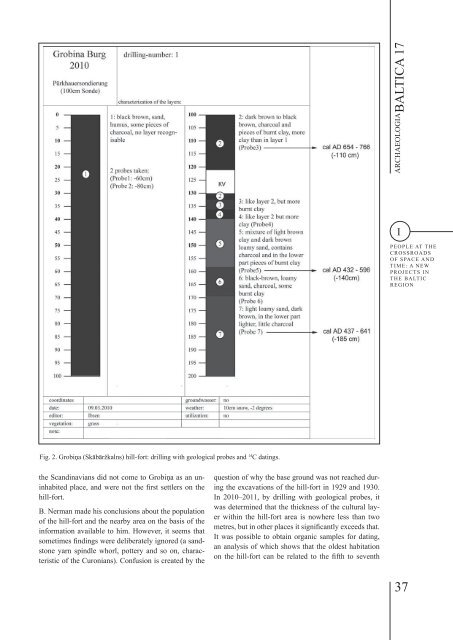BALTICA17 - KlaipÄdos universitetas
BALTICA17 - KlaipÄdos universitetas
BALTICA17 - KlaipÄdos universitetas
You also want an ePaper? Increase the reach of your titles
YUMPU automatically turns print PDFs into web optimized ePapers that Google loves.
ARCHAEOLOGIA BALTICA 17<br />
I<br />
PEOPLE AT THE<br />
CROSSROADS<br />
OF SPACE AND<br />
TIME: A NEW<br />
PROJECTS IN<br />
THE BALTIC<br />
REGION<br />
Fig. 2. Grobiņa (Skābāržkalns) hill-fort: drilling with geological probes and 14 C datings.<br />
the Scandinavians did not come to Grobiņa as an uninhabited<br />
place, and were not the first settlers on the<br />
hill-fort.<br />
B. Nerman made his conclusions about the population<br />
of the hill-fort and the nearby area on the basis of the<br />
information available to him. However, it seems that<br />
sometimes findings were deliberately ignored (a sandstone<br />
yarn spindle whorl, pottery and so on, characteristic<br />
of the Curonians). Confusion is created by the<br />
question of why the base ground was not reached during<br />
the excavations of the hill-fort in 1929 and 1930.<br />
In 2010–2011, by drilling with geological probes, it<br />
was determined that the thickness of the cultural layer<br />
within the hill-fort area is nowhere less than two<br />
metres, but in other places it significantly exceeds that.<br />
It was possible to obtain organic samples for dating,<br />
an analysis of which shows that the oldest habitation<br />
on the hill-fort can be related to the fifth to seventh<br />
37

















